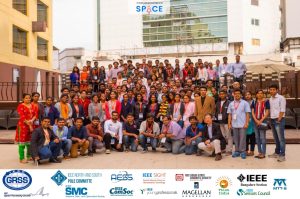Summary
This case study explores the commercialization process of Simyog, a startup in the automotive electronics industry. It discusses the challenges faced, strategies implemented, and outcomes achieved. It also provides valuable insights and lessons for other startups looking to navigate the complex landscape of commercialization.
Contributed by Dr Arjun Shetty, Senior-Editor at IEEE YP IMPACT Blog
SimYog Technology Pvt. Ltd. is a startup headquartered in Bangalore, India, with a mission to enable “Agile for Hardware Design.” The company focuses on providing EMI/EMC simulation software for front-loading at the early design stage. SimYog was founded in 2017 by Prof. Dipanjan Gope, Dr. Bibhu Prasad Nayak, Dr. Harikiran Muniganti, Mr. Anant Devi and Dr. Arkaprovo Das, leveraging their research and expertise in applied electromagnetics. Their goal was to develop design and signoff tools that addressed the increasing importance of electronics in the automotive industry. With a vision to translate their research into a viable commercial product, they embarked on a journey to overcome various challenges and establish SimYog as a leading player in the field.
Question 1: Could you give us a brief overview of SimYog and its mission?
Answer: From 2017 until December 2020, I was part of SimYog, where I served as the co-founder and principal R&D engineer, focusing on simulation. Our primary mission was to develop design and signoff tools for automotive electronics. This initiative arose from the increasing importance of electronics in the automotive industry. Even in traditional vehicles, the bill of materials has shifted towards being more electrical and electronic rather than mechanical. With the rise of electric vehicles, this trend has intensified, requiring advanced electronic design tools for efficient development.
Question 2: What were the challenges you faced during the process of commercializing your research?
Answer: Commercializing our research presented several significant challenges. One of these challenges was securing funding. While academia emphasizes publishing papers, in the entrepreneurial landscape, the challenge lies in ensuring that the developed technology can be practically applied across various industry scenarios. This comes with high stakes and demands financial resources to support a dedicated and motivated team working towards the mission. The strategy is typically to start in a low cash flow mode and gradually expand the team as resources allow.
Another major hurdle was the lack of brand recognition. Establishing brand identity is a time-consuming process that requires continuous effort. Additionally, being a startup, especially based in India where the startup ecosystem was still evolving at the time, we faced skepticism. Overcoming this bias and instilling trust in investors and potential customers regarding our capabilities to deliver world-class products was an additional challenge. Changing the perception that a startup from a less established ecosystem could produce high-quality solutions became a crucial aspect of our journey.
As a business-to-business (B2B) entity, we encountered both advantages and limitations. On the positive side, the B2B model allowed us to engage in technical discussions with customers who shared our tech-oriented perspective. However, the limitation lay in the indirect connection to end-users. In a B2B setup, where the clientele is other businesses, reaching and guaranteeing a direct impact on end-users—common individuals employing our products—was a challenge. It underscored the need for a distinct business model tailored to this market segment.
Question 3: What were some of the strategies you used to overcome these challenges in terms of funding and networking?
Answer: Overcoming the challenge of funding required a meticulous approach. Establishing partnerships and cultivating a robust network became imperative. Fortunately, our co-founder, Prof. Dipanjan Gope, who also served as my advisor, brought valuable insights, having navigated a successful startup venture in the United States. While the geographical shift to India introduced distinct conditions, his guidance proved instrumental.
Initiating partnerships involved extensive networking with venture capitalists and companies. Drawing on our advisor’s experience, we successfully secured investment from both a multinational corporation and a venture capitalist. The process, however, was far from straightforward. Negotiations with multinational companies and venture capitalists, given the financial stakes involved, proved intricate. Multiple rounds of meetings were conducted, characterized by incremental progress until the funds were secured.
Beyond securing funds, negotiations also extended to determining the equity distribution among company entities, including co-founders, investors, and a reserved stock pool for incentivizing employees. Striking the right balance in the percentage of stocks traded for the funds obtained was a pivotal aspect of this process.
Addressing the lack of brand recognition, especially when homegrown products are met with skepticism, required strategic engagement. We made a concerted effort to reach out not only to local branches but also to the headquarters of prominent companies. Even if it required traveling to different countries, we recognized the importance of breaking stereotypes and establishing credibility. By making an impression at the headquarters, we found that garnering support from local regional branches became a smoother process.
Question 4: What were some of the strategies you used to overcome the challenges in terms of focusing on a niche market?
Answer: The key strategy involved identifying and capitalizing on a niche market, coupled with the development of a highly specialized product that sets us apart from competitors. This dual focus proved pivotal for us.
Firstly, honing in on a niche market is crucial, especially when entering a competitive landscape. In a B2B industry, finding a specific market segment where your expertise can shine is essential. For us, this meant targeting the automotive segment, recognizing its significance and potential. By narrowing our operational focus, we were able to distinctly position ourselves, differentiating from competitors both in terms of market and application.
Secondly, the uniqueness of the product played a pivotal role. Tailoring our product to align precisely with customer needs was a continuous process. Regular feedback from customers allowed us to fine-tune our offerings to their specific requirements. This not only ensured alignment with customer expectations but also allowed us to introduce features that were distinct from what competitors were providing. The goal here was to minimize overlap and create a product that addressed specific customer pain points, setting us apart in the market.
It is important to understand that technological advancements are often emulated by competitors. Therefore, relying solely on technological superiority might not be a sustainable strategy.
Question 5: What were some of the strategies you used to overcome challenges in terms of investing in marketing and branding?
Answer: Navigating the initial stages of a startup demands a strategic focus on core aspects before delving into extensive branding and marketing endeavors. At this juncture, where resources are limited, prioritizing foundational elements takes precedence.
Initially, directing efforts towards becoming skilled tech developers, defining the product, engaging with potential users, and establishing crucial contacts outweigh the immediate need for extensive marketing or branding initiatives. This emphasis stems from the understanding that without a tangible and refined product, marketing lacks a substantial foundation. Therefore, channeling energy into developing a robust product and understanding the market becomes the focal point.
As the startup progresses and gains traction, entering the realm of marketing and branding becomes more viable. Once the product has found its footing in the market, strategies for marketing and brand development can be implemented. However, the journey, especially in the nascent stages, remains an open-ended exploration. While insights from experienced advisors can guide certain decisions, much of the trajectory unfolds through trial, error, and intuition. In essence, the early stages demand a measured approach, prioritizing product development and market understanding over extensive marketing efforts.
We consciously tried to shift our perspective to that of a customer, posing critical questions—what would we seek as customers? What are our pain points? This allowed us to glean insights that significantly shaped our product. Recognizing the fundamental truth that the customer holds a paramount position, we realized that, irrespective of one’s expertise in science or technology, success hinges on meeting customer expectations.
Question 6: What were the results of commercialization efforts and how did you quantify them?
Answer: There isn’t a one-size-fits-all answer to this. Rather, distinct metrics must be established across various facets of the endeavor, encompassing research, development, and subsequent commercialization. Distinguishing between research and development is paramount. Quantification is imperative for both, beginning with the technological aspect. The innovative ideas introduced into the equation serve as a quantifiable metric at the outset. This initial focus is often directed towards the technology, where quantification is facilitated through patents and intellectual property rights. However, this approach is contingent upon the industry, with nuances such as hardware patents being more enforceable than their software counterparts.
Navigating the challenges of quantification reveals a multi-faceted process. While patents provide a tangible indicator, they aren’t universally applicable across all segments of an enterprise. Despite these challenges, patents serve as one of several indicators for technological advancement. Moving beyond patents, other undisclosed metrics, constituting the ‘secret sauce,’ play a pivotal role. Documentation elucidating the role of this proprietary knowledge in technological development adds another layer of quantification.
Traditional academic metrics, such as the number of published papers, may not carry the same weight in this context. However, conference publications emerge as a pertinent metric, portraying innovation in the technological domain. Importantly, these conference papers often manifest as collaborative efforts, involving not just the technical team but also collaborators, customers, and investors. This collaborative approach extends the metric to encapsulate the end-users of the product, making it a comprehensive indicator of innovation in the technology sector. In essence, the quantification of commercialization efforts spans a spectrum, from intellectual property rights to collaborative conference publications, offering a nuanced and multifaceted evaluation of success.
When evaluating the success of your product in the realm of commercialization, a distinct set of indicators or metrics comes into play. This focus on products centers around features and the adept handling of customer pain points. The goal is to ensure a gradual disappearance of these pain points, thereby enriching the product over time. In the domain of tech development, additional aspects such as quality testing and checks play a crucial role. The type of product being developed will dictate the specifics of these quality checks. Part of the process involves the courage to say no to certain customer requests. Not every feature may be feasible within the product, considering constraints like resources, finances, and timelines. This ability to make informed decisions and manage customer expectations contributes significantly to the strategic analysis of how well the product is evolving. We tracked the progression of customer interactions at various stages: from initial contact to active engagement, near closure, and, ultimately, signed deals. The key metrics we prioritized were the influx of new customers per month or quarter.
In the initial phases, we didn’t emphasize quantifying marketing and sales activities extensively. Given our B2B nature, the need for widespread marketing wasn’t as immediate. A good product, effectively pitched, created a ripple effect through word of mouth—a powerful tool in niche B2B markets. The emphasis was on convincing customers that we were world-class and the best in the business. As the customer base expanded, there emerged a stage beyond my tenure at the company where more structured management frameworks were likely implemented for marketing. This involved considerations like which channels to utilize—social media handles, LinkedIn, and others. The focus shifted to wider outreach, keeping in mind the unique context of reaching out to other businesses rather than end consumers. The early strategy revolved around the product’s excellence, effective pitching, and the potency of word-of-mouth within the B2B ecosystem. Although I’m not privy to the current strategies of the company, this was our approach in the formative days.






